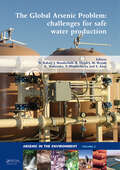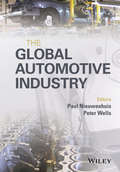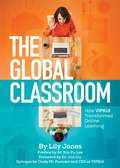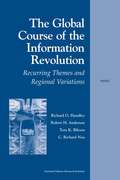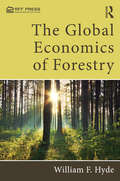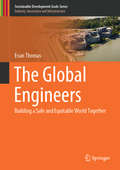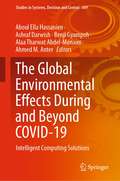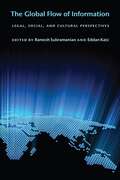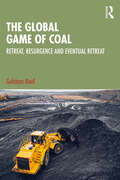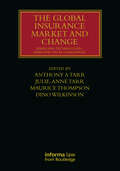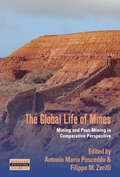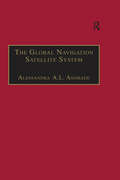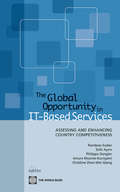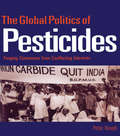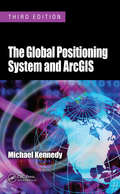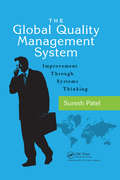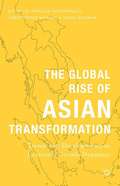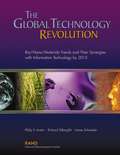- Table View
- List View
The Global Arsenic Problem: Challenges for Safe Water Production (Arsenic in the environment)
by Jochen Bundschuh Prosun Bhattacharya Marek Bryjak Nalan Kabay Bruce Hendry Kazuharu Yoshizuka Suer AnacA prevalent and increasingly important issue, arsenic removal continues to be one of the most important areas of water treatment. Conventional treatment plants may employ several methods for removing arsenic from water. Commonly used processes include oxidation, sedimentation, coagulation and filtration, lime treatment, adsorption onto sorptiv
The Global Automotive Industry
by Peter Wells Paul NieuwenhuisThe automotive industry is still one of the world's largest manufacturing sectors, but it suffers from being very technology-focused as well as being relatively short-term focused. There is little emphasis within the industry and its consultancy and analyst supply network on the broader social and economic impacts of automobility and of the sector that provides it. The Global Automotive Industry addresses this need and is a first port of call for any academic, official or consultant wanting an overview of the state of the industry. An international team of specialist researchers, both from academia and business, review and analyse the key issues that make vehicle manufacturing still the world's premier manufacturing sector, closely tied in with the fortunes of both established and newly emerging economies. In doing so, it covers issues related to manufacturing, both established practices as well as new developments; issues relating to distribution, marketing and retail, vehicle technologies and regulatory trends; and, crucially, labour practices and the people who build cars. In all this it explains both how the current situation arose and also likely future trajectories both in terms of social and regulatory trends, as the technological, marketing and labour practice responses to those, leading in many cases to the development of new business models. Key features Provides a global overview of the automotive industry, covering its current state and considering future challenges Contains contributions from international specialists in the automotive sector Presents current research and sets this in an historical and broader industry context Covers threats to the industry, including globalization, economic and environmental sustainability The Global Automotive Industry is a must-have reference for researchers and practitioners in the automotive industry and is an excellent source of information for business schools, governments, and graduate and undergraduate students in automotive engineering.
The Global Classroom: How VIPKID Transformed Online Learning
by Lily JonesBehind the Scenes of a Revolution in EducationIn 2013, Cindy Mi, a high school dropout turned English teacher, founded VIPKid with an innovative vision for education: facilitating personalized, one-on-one sessions with students and tutors from around the world. Six years later, her brainchild boasts a $3 billion valuation and connects approximately 500,000 students with 60,000 teachers worldwide. Thisis the story of a revolution in education.The Global Classroom takes readers inside the startup&’s history, educational innovation, and unprecedented success. With a foreword from Mi, the book takes a deep dive into a new educational model and investigates how the company&’s platform has diversified to serve the needs of students from countries across the globe. Readers will hear from VIPKid&’s executives, teachers, students, and parents as they discuss the company&’s values, its tangible success, and its impact on their lives.The Global Classroom is an inside look at the model for education in the 21st century and beyond.
The Global Coal Market
by Mark C. Thurber Thurber, Mark C. and Morse, Richard K. Richard K. MorseCoal has been the world's fastest-growing energy source in absolute terms for over a decade. Coal also emits more CO2 than any other fossil fuel and contributes to serious air pollution problems in many regions of the world. If we hope to satisfy the demand for affordable energy in emerging economies while protecting the environment, we need to develop a keen understanding of the market that supplies coal. This book offers an in-depth analysis of the key producers and consumers that will most influence coal production, transport, and use in the future. By exploring how countries such as China, India, Indonesia, Australia and South Africa have developed their respective coal industries - and how these industries link together through the international coal trade - experts shed light on how the global coal market may evolve, and the economic and environmental implications. This book is the most comprehensive treatment of these topics to date and will appeal to a wide readership, including scholars and practitioners working on energy economics and policy.
The Global Course of the Information Revolution
by C. Richard Neu Robert H. Anderson Tora K. Bikson Richard HundleyAdvances in information technology are heavily influencing ways in which business, society, and government work and function throughout the globe, bringing many changes to everyday life, in a process commonly termed the "information revolution." This book paints a picture of the state of the information revolution today and how it will likely progress in the near- to mid-term future (10 to 15 years), focusing separately on different regions of the world-North America, Europe, the Asia-Pacific region, Latin America, the Middle East and North Africa, and sub-Saharan Africa.
The Global Cybercrime Industry
by Nir KshetriThis book is about the global cybercrime industry, which according to some estimates, is a US$1 trillion industry and is growing rapidly. It examines economic and institutional processes in the cybercrime industry, provides insights into the entrepreneurial aspect of firms engaged in cyber-criminal activities, takes a close look at cybercrime business models, explains the global variation in the pattern of cybercrimes and seeks to understand threats and countermeasures taken by key actors in this industry. This book's distinguishing features include the newness, importance, controversiality and complexity of the topic; cross-disciplinary focus, orientation and scope; theory-based but practical and accessible to the wider audience; and illustration of various qualitative and quantitative aspects of the global cybercrime industry.
The Global Digital Divides
by James B. Pick Avijit SarkarThis book analyzes extensive data on the world's rapidly changing and growing access to, use and geographies of information and communications technologies. It studies not only the spatial differences in technology usage worldwide, but also examines digital differences in the major world nations of China, India, the United States and Japan at the state and provincial levels. At the global level, factors such as education, innovation, judicial independence and investment are important to explaining differences in the adoption and use of technology. The country studies corroborate consistent determinants for technology usage for education, urban location, economic prosperity, and infrastructure, but also reveal unique determinants, such as social capital in the United States and India, exports in China and working age population and patents in Japan. Spatial patterns are revealed that indicate clusters of high and low technology use for various nations around the world, the countries of Africa and for individual states/provinces within nations. Based on theory, novel findings and phenomena that have remained largely unreported, the book considers the future of the worldwide digital divides, the policy role of governments and the challenges of leadership.
The Global Economics of Forestry
by William F. HydeThis book traces the economic and biological pattern of forest development from initial settlement and harvest activity at the natural forest frontier to modern industrial forest plantations. It builds from diagrams describing three discrete stages of forest development, and then discusses the management and policy implications associated with each, supporting its observations with examples and data from six continents and from both developed and developing countries. It shows that characteristic distinctions between the three stages make forestry unusual in natural resource management and that effective policy requires different, even contrasting, decisions at each stage. William F. Hyde’s comprehensive discussion covers a wide range of issues, including the impacts of both specific forest policies and broader macroeconomic policies, the unique requirements of current issues such as global warming, biodiversity and tourism, and the complexities of the different forest products industries. Concluding chapters review the roles of the newer institutional landowners, of smaller private and farm landowners, and of public agencies. This highly-original volume reaches far beyond forest economics; it explains what forestry can do for regional development and environmental conservation and what policies designed for other sectors and the macro-economy can do for forestry.
The Global Engineers: Building a Safe and Equitable World Together (Sustainable Development Goals Series)
by Evan ThomasThe Global Engineers: Building a Safe and Equitable World Together, is inspired by the opportunities for engineers to contribute to global prosperity. This book presents a vision for Global Engineering, and identifies that engineers should be concerned with the unequal and unjust distribution of access to basic services, such as water, sanitation, energy, food, transportation, and shelter. As engineers, we should place an emphasis on identifying the drivers, determinants, and solutions to increasing equitable access to reliable services. Global Engineering envisions a world where everyone has safe water, sanitation, energy, food, shelter, and infrastructure, and can live in health, dignity, and prosperity.This book seeks to examine the role and ultimately the impact of engineers in global development. Engineers are solutions-oriented people. We enjoy the opportunity to identify a product or need, and design appropriate technical solutions. However, the structural and historical barriers to global prosperity requires that Engineers focus more broadly on improving the tools and practice of poverty reduction and that we include health, economics, policy, and governance as relevant expertise with which we are conversant.Engineers must become activists and advocates, rejecting ahistorical technocratic approaches that suggest poverty can be solved without justice or equity. Engineers must leverage our professional skills and capacity to generate evidence and positive impact toward rectifying inequalities and improving lives.Half of this book is dedicated to profiles of engineers and other technical professionals who have dedicated their careers to searching for solutions to global development challenges. These stories introduce the reader to the diverse opportunities and challenges in Global Engineering.
The Global Environmental Effects During and Beyond COVID-19: Intelligent Computing Solutions (Studies in Systems, Decision and Control #369)
by Ashraf Darwish Aboul Ella Hassanien Benji Gyampoh Alaa Tharwat Abdel-Monaim Ahmed M. AnterThis book aims through 11 chapters discussing the problems and challenges and some future research points from the recent technologies point of view such as artificial intelligence and the Internet of things (IoT) that can help the environment and healthcare sectors reducing COVID-19.
The Global Flow of Information: Legal, Social, and Cultural Perspectives (Ex Machina: Law, Technology, and Society #5)
by Ramesh Subramanian Eddan KartzThe Internet has been integral to the globalization of a range of goods and production, from intellectual property and scientific research to political discourse and cultural symbols. Yet the ease with which it allows information to flow at a global level presents enormous regulatory challenges. Understanding if, when, and how the law should regulate online, international flows of information requires a firm grasp of past, present, and future patterns of information flow, and their political, economic, social, and cultural consequences.In The Global Flow of Information, specialists from law, economics, public policy, international studies, and other disciplines probe the issues that lie at the intersection of globalization, law, and technology, and pay particular attention to the wider contextual question of Internet regulation in a globalized world. While individual essays examine everything from the pharmaceutical industry to television to “information warfare” against suspected enemies of the state, all contributors address the fundamental question of whether or not the flow of information across national borders can be controlled, and what role the law should play in regulating global information flows.Contributors: Frederick M. Abbott, C. Edwin Baker, Jack M. Balkin, Dan L. Burk, Miguel Angel Centeno, Dorothy E. Denning, James Der Derian, Daniel W. Drezner, Jeremy M. Kaplan, Eddan Katz, Stanley N. Katz, Lawrence Liang, Eli Noam, John G. Palfrey, Jr., Victoria Reyes, and Ramesh Subramanian
The Global Forest Sector: Changes, Practices, and Prospects
by Eric Hansen Rajat Panwar Richard VloskyChanges in production, demand, supply, and trade patterns; the impact of green building and bioenergy on industry practices and policy infrastructure; and new economies with production advantages and large consumption bases all present challenges and opportunities in the forest sector. With contributions from leading experts in academia and profess
The Global Game of Coal: Retreat, Resurgence and Eventual Retreat
by Gulshan DietlCoal occupies a large share in the global energy basket. This book explores the ‘coal game’ within the context of shifting energy geopolitics, the ‘resource war’, and the debates over climate change and energy security.Politics is a prime arena for game playing. Collaboration, competition, confrontation, and their combinations are ingredients in bilateral and multilateral dealings. The book deciphers the interactions within the coal world by resorting to the time-tested term ‘global game’. Joe Manchin in the United States, Vladimir Putin in Russia, Scott Morrison in Australia, and Gautam Adani in Australia and India have been accomplished players in the game of coal. The book looks at the coal assets and policies of major oal exporters and importers like the United States, Russia, India, Australia, and China and provides insights into the fierce contestations involved both in local and global politics and commerce over coal, climate, and security. The author discusses the role coal has played in the industrialisation of nations, prescriptions to the problem of coaluse, and varied scenarios portraying its future.The third volume in a trilogy on the use of fossil fuels, this book on coal will be of great interest to students and researchers of energy studies, international relations, environment and climate change, energy and geopolitics, security, and strategic studies. It will also be useful to policymakers, legislators, and environmentalists.
The Global Insurance Market and Change: Emerging Technologies, Risks and Legal Challenges (Lloyd's Insurance Law Library)
by Anthony A Tarr, Julie-Anne Tarr, Maurice Thompson and Dino WilkinsonThis book focuses on the global landscape in which insurance is transacted, and where it is evolving, driven from within by transformative technologies and externally by the necessity to address risks like climate change and health crises, such as the COVID-19 pandemic. It discusses the dynamic challenges and opportunities that lie ahead for the industry in areas such as on-demand insurance, embedded insurance, parametric insurance, autonomous vehicles, the rise of fintech, the cyber risk landscape and through initiatives driven by distributed ledger technology or blockchain solutions. Moreover, it covers the major external challenges confronting the global insurance market, such as the growing insurance protection gap in relation to the affordability and insurability of natural catastrophes and climate change, and pandemics like COVID-19. This book examines innovations in insurance driven by the industry as well as externally imposed changes and dynamics impacting the industry. It describes these changes, the industry’s responses and the legal framework in which they occur. It canvasses additional regulatory and law reform initiatives that may be necessary to achieve an effective balance between the various competing interests. The book is the first to address these matters holistically with a particular focus upon insurance law, it will describe these changes and industry responses and the legal framework in which they occur. The Global Insurance Market will be directly relevant to legal professionals, insurers, insurtechs, fintechs, brokers, CEOs of insurance companies, risk managers, legal counsel, academics, researchers, the judiciary, and policy makers. It will also serve as a valuable resource for students of all levels.
The Global Life of Mines: Mining and Post-Mining in Comparative Perspective (Dislocations #37)
by Antonio Maria Pusceddu Filippo M. ZerilliResource extraction exists in diverse settings across the world and is carried out through different practices. The Global Life of Mines provides a comprehensive framework examining the spatial and temporal relationships between mining and postmining as interrelated and coexisting features within the global minescape. The book brings together scholars from various fields, such as anthropology, geography, sociology and political science, examining ethnographic case studies throughout the Americas (Bolivia, Brazil, Peru, USA), Africa (Democratic Republic of Congo) and Europe (Italy, Arctic Norway and Spain).
The Global Movement and Tracking of Chemical Manufacturing Equipment: A Workshop Summary
by Kathryn HughesDual-use applications for chemical manufacturing equipment have been recognized as a concern for many years, and export-control regulations worldwide are in place as a result. These regulations, in conjunction with the verification and inspection requirements of Article VI of the Chemical Weapons Convention, are designed to support non-proliferation of manufacturing equipment suitable for production of chemical warfare agents. In recent years, globalization has changed the distribution of chemical manufacturing facilities around the world. This has increased the burden on current inspection regimes, and increased the amount of manufacturing equipment available around the world. Movement of that equipment, both domestically and as part of international trade, has increased to accommodate these market shifts. To better understand the movement and tracking of chemical manufacturing equipment of dual-use concern, the Project on Advanced Systems and Concepts for Countering Weapons of Mass Destruction at the Naval Postgraduate School contracted with the Board on Chemical Sciences and Technology of the National Research Council to hold a workshop on the global movement and tracking of chemical manufacturing equipment. The workshop, held in May 2014, looked at key concerns regarding the availability and movement of equipment for chemical manufacturing, particularly used and decommissioned equipment that is of potential dual-use concern. The workshop examined today's industrial, security, and political contexts in which these materials are being produced, regulated, and transferred. The workshop also facilitated discussions about current practices, including consideration of their congruence with current technologies and security threats in the global chemical industrial system. "The Global Movement and Tracking of Chemical Manufacturing Equipment" summarizes the presentations and discussion of the event.
The Global Navigation Satellite System: Navigating into the New Millennium
by Alessandra A.L. AndradeThe book constitutes a valuable guide to the implementation of the CNS/ATM system towards ensuring safe, efficient and orderly evolution of international air transport. It uses a pragmatic approach in addressing the major legal, institutional, technical, political and economic aspects underlying the Global Navigation Satellite System, which is expected to play a fundamental role in aviation safety and air navigation world-wide. The book also examines, through well-reasoned analysis and research, the various controversial and relevant issues which will dominate the system in the years to come. The author demonstrates a profound grasp of the subject-matter through a sustained absorption of technical, institutional and legal principles applying to this complex subject. This is brought to bear in the coherent structure and logical organisation of the chapters which makes the book an invaluable tool for the aviation community, scholars and national and international regulatory authorities. It will also be immensely useful for practitioners who work towards further development and implementation of the CNS/ATM system. There has been no comparable work previously published.
The Global Opportunity in IT-Based Services
by Christine Zhen-Wei Qiang Randeep Sudan Arturo Muente-Kunigami Philippe Dongier Seth AyersRapid advances in information technology (IT) and the resulting global connectivity are fueling dynamic growth in the services sector. Demand for IT and IT-enabled services (ITES) is estimated to represent a $500 billion annual market, of which only about 20 percent has been realized. Thus, this sector is creating new opportunities for economic growth, social empowerment, and grassroots innovation in developing countries. The potential for employment for youth and women is a particular benefit. This book is a practical guide for policy makers aiming to grow their IT services and ITES industries. It defines the development impact of the two industries and then analyzes factors crucial to the competitiveness of a country or location-including skills, cost advantages, infrastructure, and a hospitable business environment. It examines the potential competitiveness of small countries and of least developed countries specifically. This volume presents the Location Readiness Index, a modeling tool developed by McKinsey and Company for the World Bank and the Information Development Program. The index helps countries to identify their areas of relative strengths and weaknesses and to focus their efforts on interventions with the greatest likelihood for success. The book concludes by discussing specific policy options for enabling growth in the IT services and ITES industries.
The Global Politics of Pesticides: Forging consensus from conflicting interests (International Environmental Governance Set Ser.)
by Peter HoughThe Global Politics of Pesticides explores the varied, and often conflicting, interests involved in the formulation of international policies on chemical pesticide manufacture and use in each of the main areas of environmental pollution, trade, development, public health, food security, biotechnology and industrial safety and explains why some aspects of pesticide use are subject to strict international guidelines whilst others are not. The book breaks new ground in objectively examining the competing viewpoints of food producers and other pesticide users, the chemical industry, health officials, traders, environmental/consumer pressure groups and the public. It also considers how international regulation can occur in spite of the fundamental differences of opinion and seemingly opposing interests held by the key actors.
The Global Positioning System and ArcGIS
by Michael KennedySince the publication of the bestselling second edition of The Global Positioning System and GIS, the use of GPS as an input for GIS has evolved from a supporting analysis tool to become an essential part of real-time management tools in wide-ranging fields. Continued technological advances and decreased costs have altered the GPS vendor landscape significantly and opened the door to an array of receiver and software options. Retaining the in-depth description that made the previous edition so popular, The Global Positioning System and ArcGIS, Third Edition has expanded its coverage to review the capabilities and features common to most receivers. While it emphasizes Trimble and Magellan hardware and Trimble TerraSync and ESRI ArcPad software to capture data, the text’s broadened coverage makes it useful with virtually any hardware/software packages, so readers will be able to collect GPS data and install it in ArcGIS—regardless of the data capture mechanism.Covering the latest developments in this emerging field, the third edition has been updated to include: New information on automated data collection Updates to the conversion of GPS data into GIS form with ArcGIS Desktop (v. 9.3) as well as ESRI software An examination of differential correction and improvements in accuracy of collected data Additional emphasis on ArcMap and Pathfinder Office Illustrations using ArcMap to combine GPS data with other data sets including raster DRGs, DOQs, DEMs, and various vector data sets Using a top-down approach, each chapter begins with a theoretical overview followed by self-study exercises and projects that provide step-by-step guidance on applying the concepts using GPS hardware or a PC. The text includes downloadable resources with GPS data sets for exercises in Trimble SSF and ESRI shapefile formats, plus other valuable learning resources.Solutions manual available upon qualified course adoption
The Global Quality Management System: Improvement Through Systems Thinking
by Suresh PatelThe Global Quality Management System: Improvement Through Systems Thinking shows you how to understand and implement a global quality management system (GQMS) to achieve world-class business excellence. It illustrates the business excellence pyramid with the foundation of management systems at the system level, Lean System at the operational level,
The Global Rise Of Asian Transformation
by Pongsak Hoontrakul Christopher Balding Reena MarwahAsian countries are catching up with the West by transforming their primarily agrarian societies into industrial powerhouses. Manufacturing is driving innovation, productivity growth, and higher standards of living for billions of Asians. In the colonial past, the Asian production and supply chains served Western consumers. The world is now poised to evolve, led by a unified Asian business landscape capable of driving sustainable global growth within industries and markets. The Global Rise of Asian Transformation provides insights into the complex process of macro-political and economic dynamics reshaping the business landscape throughout Asia. This edited collection lays bare the megatrends that are challenging the region, including emerging consumers, urbanization, infrastructure, climate change, and energy megatrends that will further bolster the region's world standing if governments and businesses handle them adeptly. Case studies of major international companies, such as Sony, Lenovo, and Tata Motors, are also included.
The Global Synthetic Ammonia Industry: History and Developments (Perspectives on the History of Chemistry)
by Anthony S. TravisThis monograph is the first comprehensive historical overview of the global synthetic ammonia industry, highlighting its critical role in fixing nitrogen from the air in order to produce the fertilizers that support a significant portion of the world&’s population. While the first part includes the storied Haber-Bosch process, introduced in 1913 by the German firm BASF, its main focus is on the largely forgotten Italian chemist Luigi Casale, the inventor of an alternative synthetic ammonia process. Casale had the distinction of launching the global synthetic ammonia industry through, and unlike BASF, the licensing of his technology. The narrative here incorporates the first biography of Casale, with descriptions of his innovations and the early years of his company, Ammonia Casale SA. Technical challenges, relationships with collaborators and investors, and patent issues are discussed. The second part, through a macro perspective, explores the industry&’s international expansion, the evolution of novel technologies, and contributions to the Green Revolution. Included are the roles of engineering contractors, high-capacity manufacturing units, and geopolitical contexts. The final chapter covers the recent past and briefly looks to the future with moves towards sustainability within the context of green hydrogen and ammonia production. This story of one of the world&’s most important industries is recommended for historians of modern science, technology, and business, chemical engineers, practitioners in the petroleum and chemical industries, and readers interested in technological advances that have shaped our world today.
The Global Technology Revolution
by Philip S. Anton Richard Silberglitt James SchneiderBeyond the agricultural and industrial revolutions of the past, a globaltechnology revolution is currently changing the world. This book discussesthe broad, multidisciplinary, and synergistic trends in this revolution,including genomics, cloning, biomedical engineering, smart materials, agilemanufacturing, nanofabricated computation devices, and integratedmicrosystems. The revolution's effects on human health may be the most startling as breakthroughs improve both the quality and length of human life.Biotechnology will also enable us to identify, understand, manipulate,improve, and control living organisms (including ourselves). Informationtechnology is already revolutionizing our lives, especially in the developedworld, and is a major enabler of other trends. Materials technology willproduce products, components, and systems that are smaller, smarter,multi-functional, environmentally compatible, more survivable, andcustomizable. In addition, smart materials, agile manufacturing, andnanotechnology will change the way we produce devices and improve theircapabilities. The technology revolution will not be uniform in its effectacross the globe but will play out differently depending on its acceptance,investment, and a variety of issues such as bioethics, privacy, economicdisparity, cultural invasion, and social reactions. There will be no turningback, however, since some societies will avail themselves of the revolution,and globalization will thus change the environment in which each societylives.
The Global Technology Revolution 2020, Executive Summary
by David R. Howell Philip S. Anton Anny Wong Richard SilberglittIn 2020, areas of particular importance for technology trends will include biotechnology, nanotechnology, materials technology, and information technology. The authors of this report assessed a sample of 29 countries across the spectrum of scientific advancement (low to high) with respect to their ability to acquire and implement 16 key technology applications (e.g., cheap solar energy, rural wireless communications, genetically modified crops).
